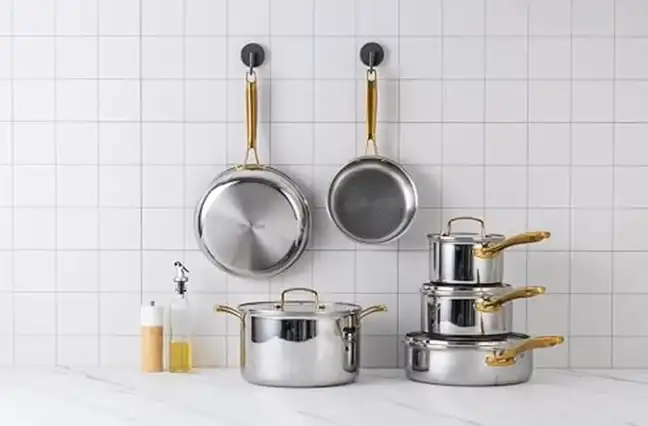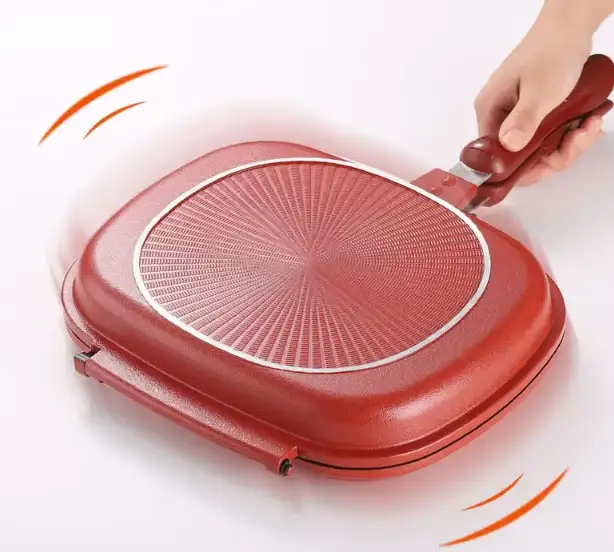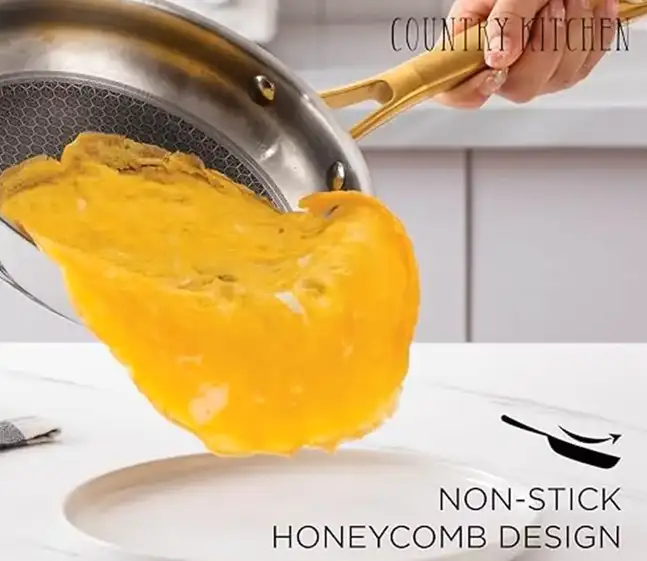Scrambled eggs are a breakfast classic loved for their fluffy texture and rich flavor. However, achieving perfection requires not just the right technique but also the right tools. Stainless steel pans, with their durability and versatility, are an excellent choice for cooking scrambled eggs. But many cooks avoid them, fearing stuck-on messes. Let’s explore how you can master scrambled eggs in stainless steel cookware and why investing in a high-quality pan is a game-changer.
Why Stainless Steel Pans Are Perfect for Cooking Eggs
Durable and Versatile
Stainless steel pans are built to last. Their robust construction resists rust, and with proper care, they can remain in your kitchen for decades. Unlike non-stick pans, they are oven-safe, making them versatile for dishes that transition from stovetop to oven, like frittatas or baked eggs.
Even Heat Distribution
Quality stainless steel pans often feature a core of aluminum or copper, which ensures even heat distribution. This eliminates hot spots that can lead to uneven cooking, a common frustration when preparing eggs.
Chemical-Free Cooking
Stainless steel is chemically inert, meaning it won’t react with acidic ingredients like tomatoes or vinegar. This ensures your eggs and other dishes retain their natural flavors without unwanted metallic tastes.
How to Cook Scrambled Eggs in a Stainless Steel Pan Without Sticking
1. Preheat the Pan Correctly
Preheating is key to non-stick cooking with stainless steel. Heat the pan over medium heat for about two minutes. To test if it’s ready, sprinkle a few drops of water into the pan. If they form little balls and glide across the surface, your pan is perfectly preheated.
2. Use the Right Amount of Fat
Butter or oil helps create a barrier between the eggs and the pan. For a 10-inch pan, use about 1/2 tablespoon of butter or a mix of butter and olive oil. Heat the fat for 5-10 seconds before adding the eggs.
3. Cook on Medium-Low Heat
Once the eggs are in, reduce the heat to medium-low. Allow them to cook undisturbed for 5-10 seconds before gently stirring. This allows a thin layer to form between the eggs and the pan, preventing sticking.
Recommended Stainless Steel Pan for Perfect Scrambled Eggs
If you’re looking to upgrade your cookware, the High-Quality Stainless Steel Pan with Tri-Ply Construction is an excellent choice. Its aluminum core ensures even heat distribution, and the polished surface makes it easier to clean after cooking. With its durable build, this pan will be a staple in your kitchen for years to come.

Additional Tips for Mastering Stainless Steel Cooking
Clean and Maintain Your Pan
After cooking, clean your pan promptly to prevent stubborn residue. A simple method involves boiling a mix of water and vinegar in the pan, then scrubbing with a soft sponge.
Seasoning Stainless Steel
While stainless steel isn’t naturally non-stick, seasoning it can enhance its performance. Rub a thin layer of oil onto the pan after cleaning, then heat it until it starts to smoke slightly. This creates a non-stick layer that improves with use.
Upgrade Your Cooking with the Right Tools
For those who enjoy exploring their culinary skills, having the right equipment can make all the difference. Another excellent addition to your kitchen is the Stainless Steel Frypan with Copper Core. It’s ideal for achieving perfectly fluffy scrambled eggs and elevating your overall cooking experience.

When to Replace Your Stainless Steel Pan: Signs to Watch For
Maintaining high-quality cookware is essential for food safety and cooking efficiency. Stainless steel pans, renowned for their durability, still have a lifespan. Recognizing signs that it’s time for a replacement can save you from uneven cooking, food contamination, or safety hazards. Here’s what to look for:
1. Persistent Tarnish or Scorch Marks
If your stainless steel pan develops tarnish or scorch marks that resist thorough cleaning, it’s a sign of wear. These imperfections can trap food particles and oils, affecting both cleanliness and cooking results. Prolonged exposure to high heat or improper cleaning can accelerate this damage.
2. Scratches or Chipping
Visible scratches or chips, especially if the inner core is exposed in tri-ply or multi-ply pans, can lead to contamination. These surfaces can flake into your food, posing health risks. If your pan’s surface isn’t smooth anymore, consider replacing it.
3. Persistent Greasy Film
A greasy film that remains despite cleaning not only affects food presentation but can alter flavors. It also indicates that the pan’s surface is no longer effectively repelling residue, which impacts the overall cooking experience.
4. Loose or Rusty Handles
Handles that wobble or show rust are a safety hazard. A loose handle can cause spills, while rust is a clear sign of material degradation. Modern pans often have riveted or welded handles; inspect these regularly.
5. Warping
Warped pans create uneven cooking surfaces, leading to inconsistent heat distribution and potential hot spots. Warping usually results from rapid temperature changes or exposure to extreme heat.
6. Exposed Core Layer
In stainless steel pans with aluminum or copper cores, the exposure of the inner layer compromises performance. The core is designed to distribute heat evenly but becomes less effective once exposed.
Maintenance Tips to Extend Lifespan
- Clean Regularly: Use gentle cleaning agents to prevent damage. Avoid steel wool, which can scratch the surface.
- Prevent Hard Water Spots: Dry your pan immediately after washing to avoid mineral deposits.
- Avoid Overheating: Stainless steel is prone to discoloration at high temperatures. Use medium to low heat to protect your pan’s finish.
- Season If Needed: Some stainless steel pans benefit from occasional seasoning for better nonstick performance.
| Feature | Details |
|---|---|
| Material | High-Quality Stainless Steel |
| Certification | LFGB (Food Safety Certification) |
| Eco-Friendly | Yes – Non-toxic, PFOA & PFOS Free |
| Cookware Set Includes | 8-inch Frying Pan, 10-inch Frying Pan, 2-quart Sauce Pan with Lid, 3-quart Sauce Pan with Lid, 4.5-quart Sauté Pan with Lid, 8-quart Stockpot with Lid |
| Compatibility | Works with all stovetops including Induction, Gas, Electric, Halogen, Glass, and Ceramic |
| Oven & Broiler Safe | Yes, up to 550°F |
| Dishwasher Safe | Yes |
| Non-Stick Technology | Non-stick Frying Pan with Honeycomb Design for even heat distribution and easy cleaning |
| Heat Distribution | Triple-ply construction with aluminum core for quick, even heat distribution |
| Design | Mirror Finish – Adds elegance to your kitchen while offering a durable, easy-to-clean surface |
| Stainless Steel Durability | Resistant to scratches, rust, and stains – metal utensil safe and built to last |
| Pot Cover | Includes lids for saucepans, sauté pan, and stockpot for better heat retention and cooking control |
| Perfect for | Home chefs looking for high-quality, versatile cookware that performs well and enhances kitchen aesthetics |
Why Choose This Cookware Set?
- Superior Heat Distribution: The triple-ply construction ensures that your cooking is always evenly heated, allowing for perfect cooking results every time.
- Long-Lasting Elegance: With its stunning mirrored finish and durable stainless steel, this cookware set adds sophistication to any kitchen.
- Non-Stick Convenience: The non-stick frying pan with a unique honeycomb design prevents sticking, making cooking and cleaning hassle-free.
- Universal Compatibility: Suitable for all cooktops, including induction, and safe for use in the oven and broiler, making it a versatile addition to your kitchen.
- Certified Safe: Free from harmful chemicals, this cookware meets LFGB food safety standards, giving you peace of mind while cooking.
Upgrade your kitchen today with the XMSJ Cookware Set and experience the ease and elegance of cooking like a pro!
Cooking Eggs: Choosing the Right Pan
Eggs are versatile yet delicate, requiring the right tools for perfect results. Whether you’re frying, scrambling, or making frittatas, understanding how different pans interact with eggs can elevate your cooking.
Nonstick Pans: The Go-To for Eggs
Nonstick pans are ideal for cooking delicate proteins. For frying eggs, a Tramontina Professional Nonstick Fry Pan offers excellent performance. Its slick surface minimizes sticking, requiring only a small amount of fat for flavor and texture.
- Pros: Easy release, minimal cleanup, and lightweight.
- Cons: Not induction-compatible and requires careful handling to maintain the coating.
Cast Iron: Seasoned and Reliable
Cast iron, like the Lodge Cast Iron Skillet, excels for stovetop-to-oven dishes, such as frittatas. Seasoning is essential for nonstick performance, and over time, the surface becomes increasingly slick.
- Pros: Retains heat well, versatile for various recipes.
- Cons: Heavy and requires regular seasoning to prevent sticking.
Carbon Steel: A Balanced Option
Carbon steel pans, such as the OXO Pre-Seasoned Carbon Steel Pan, offer a smoother surface than cast iron and are lighter. With proper seasoning, they are excellent for frying eggs and even making omelets.
- Pros: Lightweight, induction-compatible, and durable.
- Cons: Seasoning maintenance and potential for reactive behavior with acidic foods.
Stainless Steel: For the Experienced Cook
Chefs favor stainless steel pans, like the Made In Stainless Steel Skillet, for eggs due to their durability and even heating. To prevent sticking, preheat the pan and use enough fat. When the pan reaches the right temperature, water droplets should dance across the surface.
- Pros: Induction-compatible, dishwasher-safe, and long-lasting.
- Cons: Requires skill to master, prone to sticking if improperly used.
Choosing the Right Size
For versatility, a 10- or 12-inch pan works well for most households. An 8-inch pan is ideal for smaller portions or single servings.
FAQs About Egg Pans
Why Are My Eggs Sticking?
- Nonstick pans may lose effectiveness as their coating wears out.
- Cast iron or carbon steel may need additional seasoning.
- Stainless steel pans require preheating to the right temperature before adding eggs.
Is a Nonstick Pan the Best for Eggs?
Yes, especially for beginners or when cooking eggs in minimal fat. However, cast iron or stainless steel can also work with the proper technique.
By understanding your pan’s materials and maintaining them well, you can enjoy perfect egg dishes while ensuring your cookware lasts longer.

